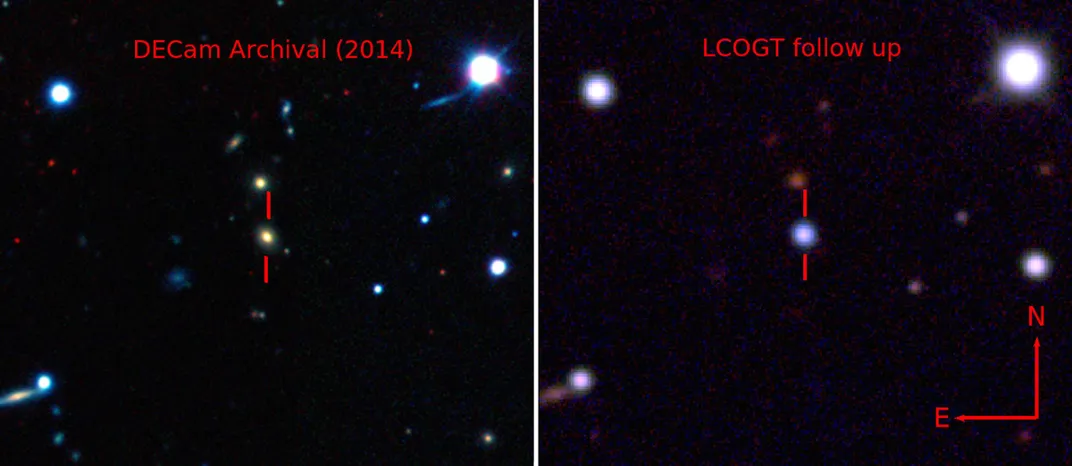Astronomers Have Found the Brightest Supernova Yet
The powerful blast is so weird that it could be a whole new kind of star explosion
/https://tf-cmsv2-smithsonianmag-media.s3.amazonaws.com/filer/c5/22/c52254a4-b38c-4949-a14d-78273cdcefe6/dong1hr.jpg)
A brilliant explosion spotted in a galaxy far, far away is the brightest supernova ever recorded, astronomers announced today.
Picked up by a night-sky survey, the explosion happened 3.8 billion light years from Earth. At that distance, the blast was 22,700 times dimmer than the faintest objects a human can see with the naked eye. But the far-flung supernova was so powerful that astronomers calculate if it had happened at the distance of the famed "dog star" Sirius, just 8 light-years away, it would have been as bright as the sun.
The All-Sky Automated Survey for SuperNovae (ASASSN), a network of telescopes divided between Chile and Hawaii, picked up the unusual object in a small galaxy on June 15. The observing team dubbed the supernova ASASSN-15lh.
The blast very likely belongs to a recently discovered class of objects known as superluminous supernovae, says study leader Subo Dong, an astronomer at the Kavli Institute for Astronomy and Astrophysics at Peking University in Beijing. But what triggered the extraordinary event is a mystery.
Astronomers group supernovae into different types based on their trigger mechanisms. A type Ia supernova occurs when a zombie star known as a white dwarf eats too much. White dwarfs are the small, dense cores left behind when a star about the mass of the sun dies. If the white dwarf has a companion star, sometimes it will draw away that star's matter, slowly increasing its own mass. Eventually the hungry white dwarf hits a physical limit and collapses, triggering an explosion.
By contrast, very massive stars—at least eight to ten times the mass of the sun—end their lives alone as type II supernovae. When these stars run out of hydrogen fuel in their cores, they begin fusing atoms into progressively heavier elements until the core is mostly iron. At this point the star collapses under its own weight, generating a huge explosion and turning the core into an extremely dense neutron star.
ASASSN-15lh was so powerful that the authors suspect the original star must have been very massive. But the chemical signatures they see in its light suggest it is suspiciously low on hydrogen, says study co-author Todd Thompson, an astronomy professor at Ohio State University.
"It's weird for massive stars not to have hydrogen," he says, but it's not impossible. "Some stars eject all their hydrogen in explosive events before they die, others lose hydrogen to binary companions." While there are some superluminous supernovae like this one that are hydrogen poor, he says, their workings are poorly understood in general.
The authors note that it's possible ASASSN-15lh got a luminosity boost from the radioactive isotope nickel-56. In a type Ia supernova, nickel forms when the gas from the companion star initiates the white dwarf's explosive end. The radioactive decay of nickel into iron and cobalt then generates light that drops off at a certain rate. But to get the kind of energy seen in ASASSN-15lh, the explosion would have needed an unlikely amount of nickel—around 30 times the mass of the sun. On top of that, the luminosity doesn't seem to be dropping off fast enough.

Another possibility is that the core of the supernova became a magnetar. These objects are neutron stars with very strong magnetic fields, and that could have pumped up the blast's power. But even a magnetar can't fully explain ASASSN-15lh—the blast would have required a rapidly spinning core with an extremely powerful magnetic field, and that's unlike any magnetar ever seen. It also would have needed to convert energy from the collapse into light more efficiently than any supernova has before.
Nailing down the mechanism behind ASASSN-15lh could help astronomers better understand superluminous supernovae, which are expected to be even more numerous in the very early universe. Greg Aldering, a staff scientist at Lawrence Berkeley National Laboratory, notes that current and future all-sky surveys should spot more of them, because these comprehensive scans of the cosmos can catch objects that aren't located near known galaxies.
Subo adds that if we can understand them better, superluminous supernovae in the early universe could serve as standard candles—objects of reliable brightness that can be used to measure cosmic distances. Future observations of other superbright star explosions could also help probe distant, very faint galaxies, because the supernovae act like giant flashbulbs, briefly illuminating the surrounding area.
Aldering says more data needs to come in from this supernova, and more of its kind need to be observed. It might be that this one is an outlier that had some additional factor pumping it up.
Robert Quimby, an associate professor at San Diego State University, says that even though the magnetar model might have problems, "the discovery of this supernova prompted a re-evaluation of the limits of magnetar-powered supernovae." But it's also possible this supernova might be a completely new type of object, he says: "Here we have a case where the number of viable models might be zero. That is very exciting."
Aldering agrees: "Nature, given enough stars out there, makes them explode in all kinds of incredible ways. Whatever one ends up being the real mechanism will probably be extremely weird."